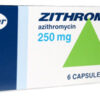Drug Classification and Formulation
Tetracycline belongs to the tetracycline class of antibiotics, primarily used to combat bacterial infections. It is available in several forms, including oral capsules, tablets, and topical formulations. Each formulation varies in dosage strength, allowing for flexibility in treatment regimens tailored to specific conditions.
Mechanism of Action
Tetracycline works by inhibiting protein synthesis in bacteria, a process vital for their growth and replication. The drug binds to the 30S ribosomal subunit, obstructing the attachment of aminoacyl-tRNA to the RNA-ribosome complex. This disruption prevents the addition of new amino acids to the nascent peptide chain, effectively stalling bacterial growth.
Indications of Use
Tetracycline is indicated for use in a variety of bacterial infections, including respiratory tract infections, urinary tract infections, and sexually transmitted infections like chlamydia. It is also employed in the treatment of acne, rosacea, and certain rickettsial infections. Its broad-spectrum activity makes it versatile for numerous clinical scenarios.
Administration and Dosage
The typical adult oral dosage for tetracycline ranges between 250 to 500 mg every 6 to 12 hours, depending on the severity of the infection. For topical forms, application is generally recommended once or twice daily. Dosage adjustments may be necessary for pediatric patients or individuals with specific renal conditions.
Pharmacokinetic Properties
Tetracycline exhibits good oral bioavailability, although it can be impaired by the presence of food or dairy products. The drug has a half-life of approximately 6 to 12 hours, necessitating multiple daily doses to maintain therapeutic levels. Tetracycline is widely distributed in body tissues and fluids, and excreted primarily in urine and feces.
Potential Drug Interactions
Tetracycline’s effectiveness may be reduced when taken with antacids, calcium supplements, or iron-containing products, as these can form insoluble complexes. Concurrent use with other antibiotics like penicillin may antagonize their effects. Oral contraceptives may also have reduced efficacy when taken with tetracycline.
Contraindications
Patients with a known hypersensitivity to tetracycline or other tetracycline derivatives should avoid this medication. It is also contraindicated in pregnancy, particularly from the second trimester, due to potential fetal harm, including enamel hypoplasia. Lactating women should avoid tetracycline, as it can be excreted in breast milk.
Adverse Effects
Common adverse effects include gastrointestinal disturbances such as nausea and diarrhea. Long-term use may lead to photosensitivity, resulting in an exaggerated sunburn reaction. Rarely, tetracycline can cause intracranial hypertension, which may present as headache and visual disturbances.
Monitoring Requirements
Patients on prolonged tetracycline therapy should be monitored for hepatic and renal function due to potential toxicity. Regular blood count assessments are advised to detect any hematological abnormalities. Patients should also be evaluated for any signs of secondary infections or adverse drug reactions.
Special Populations
The use of tetracycline in pediatric populations under eight years of age is generally avoided due to risks of tooth discoloration and delayed bone growth. In geriatric patients, careful consideration of renal function is necessary to prevent cumulative toxicity. Dose adjustments may be required in renal impairment.
Role in Multidrug Regimens
Tetracycline is sometimes used in combination with other medications to treat more complex infections, such as Helicobacter pylori infection in peptic ulcer disease. Its integration into multidrug regimens should be based on microbial susceptibility patterns and patient-specific factors to optimize therapeutic outcomes.
Storage and Disposal
Tetracycline should be stored at room temperature, away from excess heat and moisture. It must be kept in a secure location to avoid accidental ingestion by children or pets. Expired or unused tetracycline should be disposed of appropriately, following local regulations, to prevent environmental contamination or accidental exposure.
Historical Context
Discovered in the late 1940s, tetracycline was one of the first broad-spectrum antibiotics, paving the way for the development of more advanced antibiotics. Its discovery marked a significant advancement in infectious disease treatment, providing options beyond penicillin and sulfonamides.
Generic and Brand Names
Tetracycline is available under various generic names and is marketed under several brand names, such as Achromycin and Sumycin. The availability of generic options may provide a more cost-effective treatment choice for patients without compromising therapeutic efficacy.
Patient Counseling Points
Patients should be advised to take tetracycline on an empty stomach to maximize absorption, preferably one hour before or two hours after meals. They should be informed about the importance of completing the full course of therapy, even if symptoms improve, to prevent the development of resistant bacteria.
Alternative Therapies
In cases of tetracycline allergies or intolerance, alternative antibiotic classes, such as macrolides or fluoroquinolones, may be considered based on the infection’s susceptibility profile. These alternatives can provide a suitable substitute while avoiding the adverse effects associated with tetracycline use.







Reviews
There are no reviews yet.